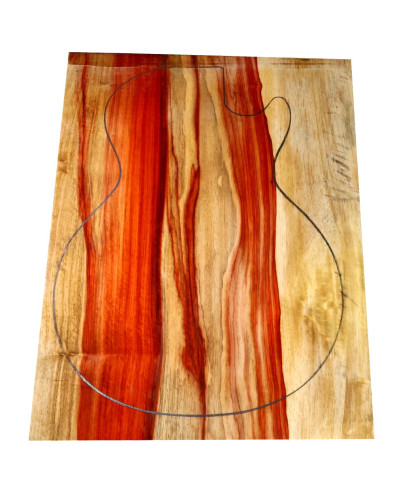- News
- 17 likes
- 824 views
- 0 comments

Reasons why Padauk Bariolé is a favorite among luthiers
Ensuring that a guitar stands out and reflects a unique personality is an essential detail in its construction. If you want your guitar to possess an exceptional character that makes it stand out, choosing the right wood is crucial. For those looking for a standout wood that is both durable and contributes unique beauty and color to their instruments, Padauk (Pterocarpus soyauxii) deserves full attention. Originating from Africa, its intense reddish color is impossible to ignore, and as if that weren't enough, it features an even more eye-catching variant: Padauk Bariolé, known for its multicolored grain patterns that turn it into a natural work of art.
In this article, we will explore why Padauk Bariolé is a luthier's favorite. Discover with Maderas Barber what makes it so special, its acoustic properties, its workability in the workshop, and tips for those looking to incorporate this wood into their projects. We will also touch on the sustainability of this species and suggest responsible usage to maximize each piece's potential.
Origin of Padauk
Padauk grows in the tropical regions of Africa, particularly in Cameroon, Gabon, and Congo. It is highly valued in the market not only for its durability but also for its vibrant red-orange color, which develops a deep brown patina over time with exposure to light, adding depth to its appearance. However, within this species lies a fascinating variant: the Bariolé.

The beauty of Bariolé
Visually, Padauk Bariolé is distinguished by its veins in various shades, ranging from reddish to brown and gold, creating a unique visual effect. This play of colors occurs due to natural variations in the density and composition of wood extractive deposits, resulting in mottled and contrasting patterns. Although it comes from the same species, Bariolé stands out for these irregular veins that make it a sought-after choice for pieces that need a distinctive and artistic touch.
A wood with visual and acoustic personality
Padauk Bariolé is not only visually striking but also contributes a warm and well-defined sound that appeals to many musicians and luthiers. With a density of 850 kg/m³ and notable resonance, it projects a balanced tone, featuring deep bass and precise highs, making it ideal for various types of string instruments.
In acoustic and electric guitars, it's common to find Padauk Bariolé used for fretboards and bodies that achieve excellent tonal balance. PRS Guitars, for example, has used it in exclusive models from their Private Stock and Custom series, taking advantage of its sustain and midrange clarity. Ibanez also incorporates it into some high-end guitars to add warmth and robustness, perfect for genres like rock and jazz.
High-quality acoustic guitar brands such as Furch and Dowina also harness the characteristics of Padauk Bariolé, using it in special editions or models that aim for a unique look and sound. Renowned luthiers like Michael Greenfield and Tom Sands use this wood in custom guitars, highlighting both its beauty and tonal quality. This type of wood allows them to work with a high-performing acoustic material while offering clients something truly special in terms of aesthetics.
Both Padauk and its Bariolé variant are excellent alternatives to traditional woods such as Rosewood. They provide a unique personality that makes each instrument not only sound good but also stand out visually for its exotic beauty.
Workability and workshop tips
Despite its density, Padauk Bariolé is quite workable. It has a medium to fine texture, typically straight grain, though sometimes slightly interlocked.
For general finishes, this wood responds well to oils and varnishes, achieving a sheen that accentuates its warm tones. For Padauk, we recommend using finishes that offer good UV protection, as its color tends to darken over time. Some luthiers prefer natural aging, but if you want to preserve its original color, opt for UV-protective lacquers.
Sustainability and responsible sourcing of padauk bariolé
Padauk Bariolé is listed in Appendix II of CITES, meaning it is not endangered but its trade is regulated to prevent overexploitation and protect wild populations. Acquiring Padauk Bariolé responsibly is not just about complying with the law but also about preserving this resource for future generations of luthiers and artisans.

For those of us working with exotic woods, this also means being smart and efficient in material use. Making the most of each piece and minimizing waste is key to sustainable use. In the workshop, this can mean careful planning of cuts, reusing offcuts for details or smaller parts of instruments, or even combining Padauk Bariolé with other woods to create unique finishes and distinct personalities in each piece.
The importance of responsible and efficient use of Padauk Bariolé
At Maderas Barber, we are aware of the importance of responsible and efficient use of Red Bariolé Wood. When cutting, we aim to maximize the yield of each board and each sectioned piece. Each one tells a story of care and respect for the resource.

















